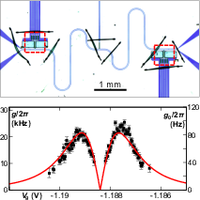We've published a press release (in German) on our recent Nature Communications publication "Quantum capacitance mediated carbon nanotube optomechanics".
Read it on the university web page!
(A summary in English can be found in a previous blog post.)
Wednesday, April 29, 2020
Thursday, April 9, 2020
Nature Communications published: "Quantum capacitance mediated carbon nanotube optomechanics"
Coupling carbon nanotube motion to microwaves is hard. Why so? Because typical electromagnetic wavelengths are in the millimeter range there, and a typical nanotube device is less than a micrometer long, with mechanical deflections of nanometers or smaller. As a result, the motion of the nanotube just does not modify the electromagnetic field much; the coupling parameters resulting from optomechanical theory are minimal.
Still, achieving such a coupling and controlling it, without resonantly driving the nanotube to large motion amplitudes, is for many reasons an attractive idea. A nanotube is a very good beam resonator, storing energy coherently for a long time; the mechanics could be used to translate quantum information between different quantum mechanical degrees of freedom. And both single electrons trapped within semiconductors (as a carbon nanotube) and superconducting coplanar microwave circuits are hot candidates for quantum computation architectures, and the topic of much research worldwide.
From this background we are excited to present a first optomechanical experiment where the motion of a suspended single carbon nanotube has been coupled to a superconducting coplanar microwave cavity; our work has been published in Nature Communications. Using the quantization of electric charge, we have been able to amplify the interaction between the two systems, vibration and electromagnetic field, by a factor 10000 compared to simple geometric predictions - and this is by far not the limit yet on what is achievable with our method. In addition, the coupling is controllable, and can be switched on and off quickly.
We obtain a so-called dispersively coupled optomechanical system - novel and exciting on one hand because of the miniaturization of the mechanical part and the coherent single electron effects, but well known on the other hand, since a huge body of theoretical and experimental research on larger (up to macroscopic scales) optomechanical systems exists. There, it has been shown that the coupling can be used for cooling of the vibration, for coherent amplification of signals, or even for arbitrary preparation of quantum states. Based on our results, also the quantum control of the string-like nanotube vibration will be reachable in the near future.
"Quantum capacitance mediated carbon nanotube optomechanics"
S. Blien, P. Steger, N. Hüttner, R. Graaf, and A. K. Hüttel
Nature Communications 11, 1636 (2020)
Still, achieving such a coupling and controlling it, without resonantly driving the nanotube to large motion amplitudes, is for many reasons an attractive idea. A nanotube is a very good beam resonator, storing energy coherently for a long time; the mechanics could be used to translate quantum information between different quantum mechanical degrees of freedom. And both single electrons trapped within semiconductors (as a carbon nanotube) and superconducting coplanar microwave circuits are hot candidates for quantum computation architectures, and the topic of much research worldwide.
From this background we are excited to present a first optomechanical experiment where the motion of a suspended single carbon nanotube has been coupled to a superconducting coplanar microwave cavity; our work has been published in Nature Communications. Using the quantization of electric charge, we have been able to amplify the interaction between the two systems, vibration and electromagnetic field, by a factor 10000 compared to simple geometric predictions - and this is by far not the limit yet on what is achievable with our method. In addition, the coupling is controllable, and can be switched on and off quickly.
We obtain a so-called dispersively coupled optomechanical system - novel and exciting on one hand because of the miniaturization of the mechanical part and the coherent single electron effects, but well known on the other hand, since a huge body of theoretical and experimental research on larger (up to macroscopic scales) optomechanical systems exists. There, it has been shown that the coupling can be used for cooling of the vibration, for coherent amplification of signals, or even for arbitrary preparation of quantum states. Based on our results, also the quantum control of the string-like nanotube vibration will be reachable in the near future.
"Quantum capacitance mediated carbon nanotube optomechanics"
S. Blien, P. Steger, N. Hüttner, R. Graaf, and A. K. Hüttel
Nature Communications 11, 1636 (2020)
Labels:
nanotubes,
physics,
regensburg,
research-group,
work
Subscribe to:
Posts (Atom)
